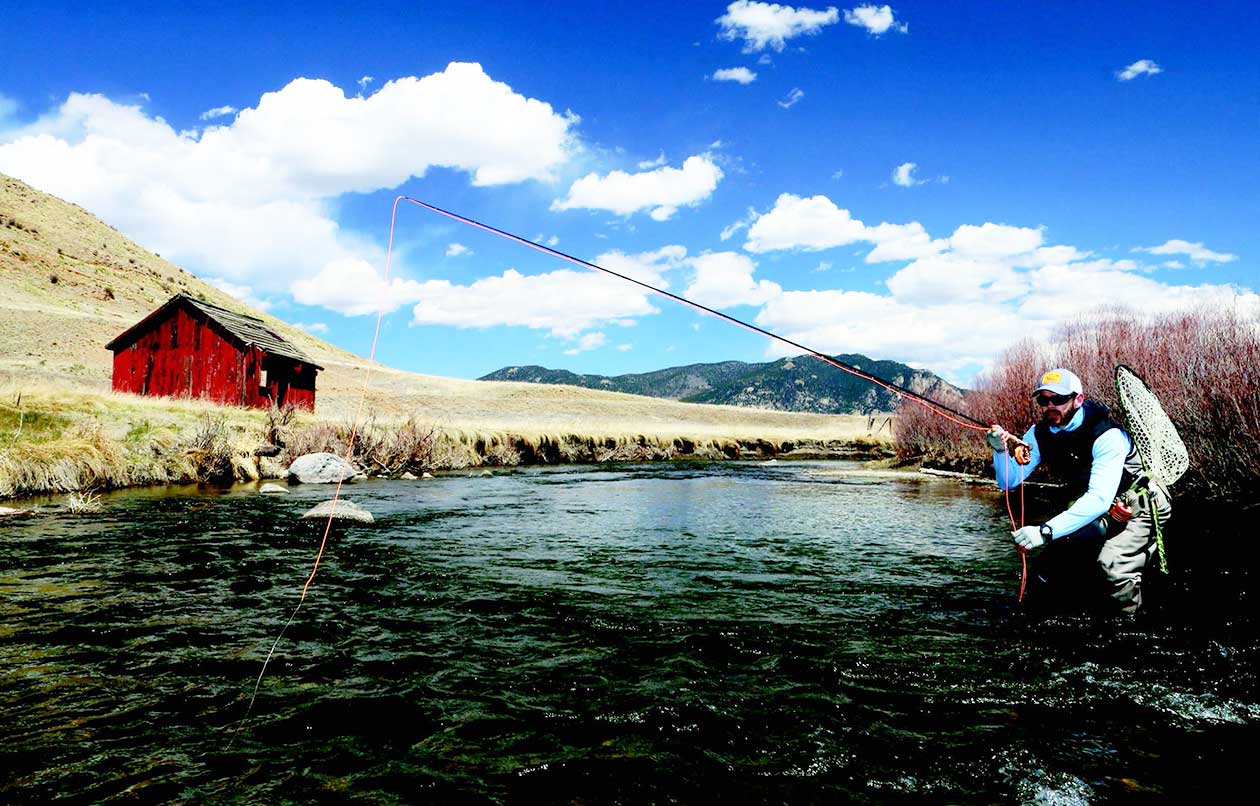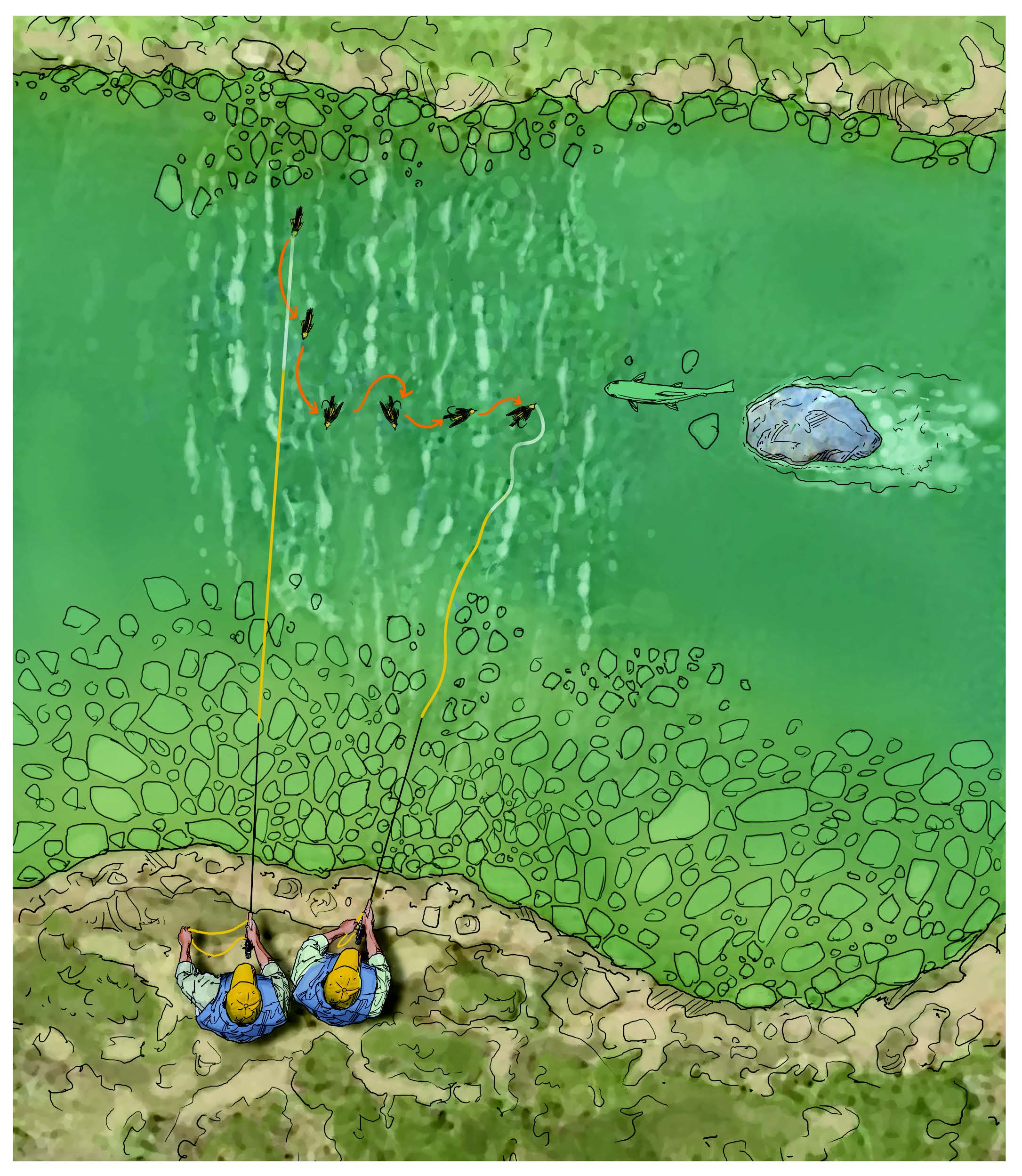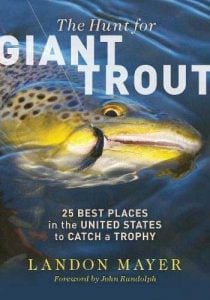The Imaginary Line

The best indicator is the trout itself when you are using the imaginary line to present to a fish. Use your peripheral vision to track the indicator as a reference of where the drift is going.
The simple details are what make you a better angler. One of my biggest learning moments in fly fishing was when I discovered the imaginary line. It was on the South Platte River in one of the prettiest sections of Colorado, Eleven Mile Canyon, in the summer of 1998. This setting at the base of towering round granite rock walls is a trout hunter’s paradise, with a river that averages 20 feet or less wide, rattled with structure, riffles, pocketwater, and deep plunge pools and water that looks like a freshly cleaned window.
I was watching a gorgeous red-sided rainbow eating emerging PMDs so hard it looked like an every-second event. I thought I knew exactly what to do, casting my presentation upstream with multiple mends, waiting for my indicator to move when it was near the target. Then while looking at the indicator as it passed by the trout, I saw the indicator move, and the fish I was looking at was still feeding while I had another fish on my rig. At that very moment the light bulb went off and I realized that what I thought was an accurate drift was not at all. In fact, it was the opposite. I was simply drifting to the water and not the fish. I then started putting the pieces together and creating the system I now use every day on the water—that imaginary line!

Notice the angler in this illustration is casting past the drifting line above the trout. This compensates for the natural direction of the drift, with tension toward the angler. Once the fly enters the viewing lane, it is seen by the fish and drifts short of the target.
Feeding fish starts with sight-fishing and seeing the target, and leads to being able to deliver the fly more effectively when you cannot see the fish and have to rely on reading the water. All of this is possible by visualizing an imaginary line from the spot where your fly first lands, or you begin your drift to the trout’s viewing lane for targets you can see or the prime feeding zone when reading water. It is the same mental focus athletes from all sports around the world use to stay the course, whether it is a batter visualizing the next hit or a boxer ducking and visualizing the next punch. I literally try to visualize every drift and eat before it occurs. I used to refer to this technique as the “dotted line,” and the system is still designed to be accurate with every cast to the trout’s viewing lane, but I have learned over the years it is easier to stay on course with each drift or delivery when envisioning a continuous line without spaces or breaks. Whether you are dead-drifting nymphs to a fish plowing emergers, feeding a cripple to an active riser, or trying to lure a giant brown from an undercut with a furry streamer imitation, all of these actions require an imaginary line for the best accuracy and results!
Drawing the Line
 When you have located the target, or target area, the next step is to evaluate the water flow and depth upstream and around the fish. While doing this you are also giving yourself a chance to watch the trout’s feeding habits: Is it lifting toward the surface, showing a preference for eating to the right, or simply wanting to be spoon-fed with the fly right above its nose? Like a basketball coach drawing out the next play during a timeout, you will then begin drawing your own line above you will then begin drawing your own line above the trout to ensure the presentation will deliver the fly to the trout you see, or ensure a drift to the area of the fish.
When you have located the target, or target area, the next step is to evaluate the water flow and depth upstream and around the fish. While doing this you are also giving yourself a chance to watch the trout’s feeding habits: Is it lifting toward the surface, showing a preference for eating to the right, or simply wanting to be spoon-fed with the fly right above its nose? Like a basketball coach drawing out the next play during a timeout, you will then begin drawing your own line above you will then begin drawing your own line above the trout to ensure the presentation will deliver the fly to the trout you see, or ensure a drift to the area of the fish.
When creating the line from reading water, look for areas where the trophy does not have to expend energy to consume its meal. Soft eddies of a turbulent run, drop-offs at the end of a riffle, and the edge of a shade line acting like a doorway to an undercut bank are all good spots for trout to remain lazy while they feed.
The line should start from the trout’s head, or viewing lane, and travel the best current line 2 to 3 feet upriver for shallow runs and 4 to 8 feet for deep runs. In stillwater scenarios, you want to cast to an imaginary line the trout will swim to. You need to watch the cruising fish to see if it is staying on a specific feeding path or moving at random. You can then make a leading line to a casting area. The distance for lakes, ponds, and reservoirs is more than for a river because the surface can be calm and the trout will feel or see disturbance easier. The distance to lead is not based on depth alone—you want to think shorter when the water has chop supplying the trout cover and long lines when it is calm.
Excerpted with permission from The Hunt for Giant Trout: 25 Best Places in the United States to Catch a Trophy (Stackpole Books, 2018)











